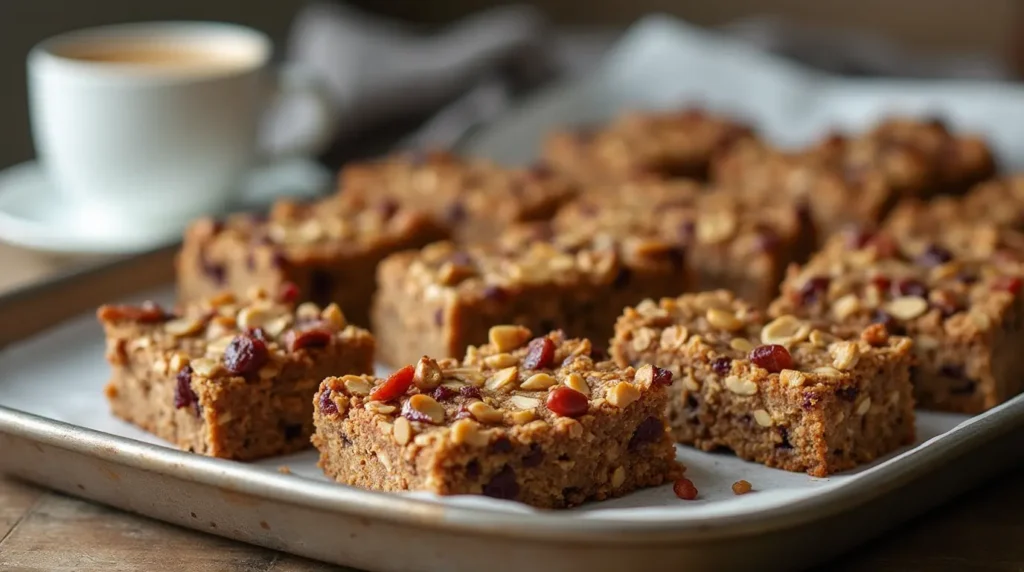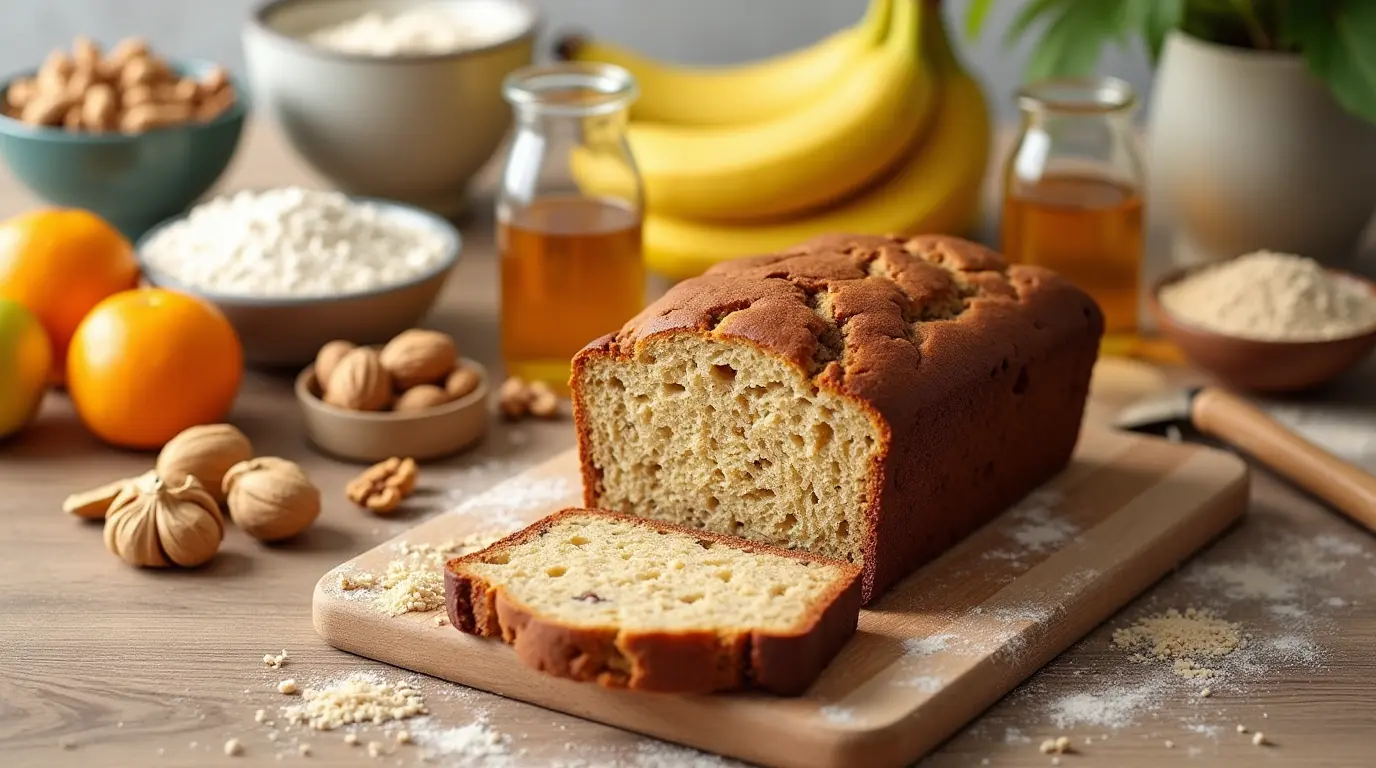Think healthy baking means dry muffins or bland cookies? Think again.
With the right swaps, like almond flour, natural sweeteners, and healthy fats, you can enjoy baked treats that satisfy your sweet tooth and your wellness goals. This guide walks you through the best recipes, ingredients, and tricks for baking better without sacrificing flavor.
Table of contents
Essential Ingredients for Healthy Baking
When it comes to crafting healthy baking recipes, choosing the right ingredients is a game-changer. With a few smart swaps, you can significantly boost the nutritional value of your baked goods while maintaining or even enhancing their flavor and texture.
Substitute Refined Sugar with Natural Sweeteners
Traditional recipes often rely heavily on refined sugar, but there are plenty of healthier alternatives:
- Honey and Maple Syrup: These natural sweeteners are packed with antioxidants and offer a rich, distinctive taste.
- Stevia or Monk Fruit: Ideal for low-calorie options, they don’t spike blood sugar levels.
- Mashed Fruits: Bananas, dates, or applesauce can sweeten desserts while adding fiber and vitamins.
Experimenting with these sweeteners not only improves health benefits but also introduces unique flavors to your treats.
Opt for Whole Grain or Gluten-Free Flours
Flour forms the foundation of most baked goods, and healthier alternatives abound:
- Whole Wheat Flour: Rich in fiber and protein, it adds a nutty flavor and texture.
- Almond and Coconut Flours: Perfect for gluten-free baking, these flours also bring healthy fats into the mix.
- Oat Flour: Made from ground oats, it’s a fantastic source of soluble fiber.
Mixing these flours can balance taste and texture while keeping recipes nutritious.
Healthy Fat Alternatives: Yogurt, Avocado, and More
Instead of butter or oil, try these substitutes:
- Greek Yogurt: Adds creaminess and cuts down on unhealthy fats.
- Mashed Avocado: A rich source of good fats that keeps baked goods moist.
- Nut Butters: Deliver protein and a subtle, nutty flavor.
These swaps not only improve the health profile of your recipes but also offer creative ways to reinvent your favorites.
Boost Nutrition with Fruits, Nuts, and Seeds
Incorporating nutrient-dense mix-ins can elevate your baking:
- Berries or Dried Fruits: Add natural sweetness and antioxidants.
- Chia or Flaxseeds: Enhance fiber and omega-3 content.
- Nuts: Almonds, walnuts, and pecans bring crunch and healthy fats.
Using these ingredients transforms your desserts into nutrient-packed treats.
For inspiration, check out this guide on high-protein desserts, which features recipes combining these wholesome ingredients.
Top 10 Healthy Baking Recipes
Exploring delicious healthy baking recipes doesn’t mean giving up indulgent flavors. From sweet to savory, here are ten standout ideas to inspire your next bake.

Healthy Banana and Zucchini Bread
This classic is given a healthy twist with whole wheat flour and mashed bananas for natural sweetness. Adding zucchini ensures moistness while sneaking in extra veggies.
Ingredient Mini Muffins
Quick, simple, and nutritious, these muffins use bananas, eggs, and almond flour. Perfect for on-the-go snacking!
Low-Sugar Carrot Cake Muffins
With shredded carrots, cinnamon, and a touch of honey, these muffins deliver all the carrot cake flavors minus the excess sugar.
Gluten-Free Vegan Lemon Cake
Using almond flour and plant-based milk, this cake is a zesty delight that accommodates dietary restrictions.
Protein-Packed Peanut Butter Cookies
Made with peanut butter, oats, and a drizzle of honey, these cookies satisfy cravings while keeping you full.
Black Bean Brownies
These fudgy brownies use black beans for a protein boost, making them a guilt-free dessert option.
Almond Flour Chocolate Chip Cookies
Swap traditional flour with almond flour and enjoy these rich, buttery cookies that are low in carbs and high in healthy fats.
Oatmeal Breakfast Bars with Fruits
Loaded with oats, dried fruits, and nuts, these bars are perfect for a wholesome morning treat.
Savory Frittata Muffins
Ideal for breakfast or snacks, these muffins use eggs, spinach, and a sprinkle of cheese for a low-carb, high-protein option.
Whole Wheat Pancakes
Fluffy and delicious, these pancakes use whole wheat flour and almond milk, proving that breakfast can be both nutritious and satisfying.
For more ideas, explore related recipes like this collection of tropical mango desserts.
Tips for Baking Healthy Recipes at Home
Healthy baking might seem tricky at first, but with a few clever tips and tricks, you’ll quickly master the art of creating tasty and nutritious treats. These practical strategies will help you bake like a pro while sticking to your healthy baking recipes.
Choosing the Right Bakeware for Healthier Results
The tools you use in baking play a significant role in how your goodies turn out:
- Nonstick Bakeware: Opt for nonstick pans to reduce the need for greasing with oil or butter. Silicone molds are also an eco-friendly, nonstick alternative.
- Portion Control Bakeware: Mini muffin tins or smaller loaf pans help manage portion sizes, ensuring you enjoy treats in moderation.
- Airy Baking Sheets: Choose perforated or lighter sheets to avoid overbaking and allow for even heat distribution.
Perfecting the Use of Healthy Substitutes
Making swaps in your recipes is key to keeping them nutritious without compromising flavor:
- Start Small: Experiment with replacing half the sugar or flour in a recipe to gauge the impact on taste and texture.
- Pair Flavors Carefully: For example, almond flour pairs well with vanilla or chocolate, while coconut flour complements citrus flavors.
- Adjust Liquids: Many healthy substitutes absorb more liquid; always tweak amounts to ensure your batter isn’t too dry.
Balancing Flavor and Texture in Healthy Baking
Baking healthy doesn’t mean sacrificing flavor or texture. Here’s how to strike the perfect balance:
- Add Spices and Extracts: Ingredients like cinnamon, nutmeg, or vanilla extract enhance taste without extra calories.
- Incorporate Moisture-Rich Additions: Mashed fruits or Greek yogurt can keep baked goods soft and moist.
- Be Patient: Healthy batters often need a little extra time to set due to their denser ingredients. Keep an eye on baking times and adjust as needed.
Creative Variations for Healthy Baking Recipes
One of the most exciting aspects of healthy baking recipes is the endless room for creativity. With a little imagination, you can tweak traditional recipes or invent entirely new ones that suit your tastes and dietary needs.
Adding Superfoods to Your Recipes
Superfoods are nutrient-packed ingredients that can transform your baked goods into even healthier treats:
- Chia Seeds and Flaxseeds: Sprinkle these into muffins, breads, or cookies for added fiber and omega-3s.
- Matcha Powder: This vibrant green tea powder not only adds color but also provides antioxidants.
- Cacao Nibs: A healthier alternative to chocolate chips, they add crunch and a deep cocoa flavor.
Incorporating these ingredients elevates your recipes, making them as beneficial as they are delicious.
Customizing Recipes for Seasonal Ingredients
Using seasonal produce keeps your baking fresh and exciting throughout the year:
- Fall: Add pumpkin puree, cinnamon, and nutmeg for warm, cozy flavors.
- Winter: Incorporate cranberries, orange zest, or even ginger for festive treats.
- Spring and Summer: Use berries, mangoes, or zucchini for light, refreshing bakes.
Seasonal ingredients not only taste better but also ensure your recipes align with nature’s rhythm.
Frequently Asked Questions (FAQs)
What is the healthiest thing to bake?
The healthiest things to bake are those made with whole grains, natural sweeteners, and healthy fats. Great options include:
Oatmeal banana muffins
Almond flour cookies
Zucchini bread with honey
Sweet potato brownies
They’re packed with nutrients, fiber, and flavor, without the guilt.
What is the healthiest dessert you can have?
The healthiest desserts are those made with whole ingredients and natural sweetness. Top picks include:
Fruit salad with a drizzle of honey
Greek yogurt with berries and chia seeds
Baked apples with cinnamon
Dark chocolate-dipped strawberries
They offer fiber, antioxidants, and satisfy your sweet tooth, naturally.
What to bake when on a diet?
When you’re on a diet, bake treats that are lower in sugar, higher in protein or fiber, and portion-controlled. Great options include:
Protein muffins (with oats and eggs)
Chia seed cookies
Almond flour brownies
Mini crustless quiches
These give you the comfort of baking without derailing your goals
Which bakery item is healthy?
Healthy bakery items often include:
Whole grain breads (like sprouted grain or 100% whole wheat)
Bran or oat muffins (low in sugar)
Banana bread made with natural sweeteners
Energy bars with nuts and seeds
Look for options with minimal added sugars, whole ingredients, and good fiber content.

